We are sharing reagents, chemicals, and constructs developed in our lab with researchers all over the world. If you would like to request materials for your research, please send us an email. Most materials require a simple Materials Transfer Agreement (MTA) between your institution and the University of Pittsburgh. Please take a look at the list below which includes structures, brief descriptions, and selected references.
materials for optochemical control of oligonucleotide function
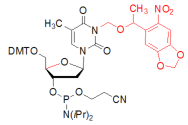
Caged thymidine phosphoramidite for the light-regulation of oligonucleotide function, especially antisense function. [61] [44] [43] [40] [29] [26]
This reagent is also commercially available at Berry & Associates and Glen Research.
This reagent is also commercially available at Berry & Associates and Glen Research.
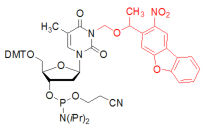
Caged thymidine phosphoramidite for the light-regulation of oligonucleotide function with two-photon excitation. [56]
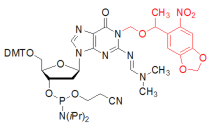
Caged deoxyguanosine phosphor-amidite for the light-regulation of oligonucleotide function. [33]
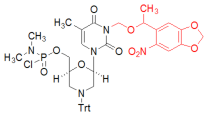
Caged thymidine morpholino monomer for the light-regulation of antisense function. [67]

Caged oligonucleotides. Please feel free to discuss the synthesis of light-activated oligonucleotides (antagomirs, antisense agents, DNA decoys, etc) with us. [61] [44] [43] [40] [29]
Caged oligonucleotides can also be obtained from TriLink Biotechnologies.
Caged oligonucleotides can also be obtained from TriLink Biotechnologies.
materials for optochemical control of small molecule modifiers of biological function
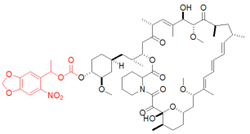
Caged rapamycin for light-activation of kinase function in mammalian cells. [70]
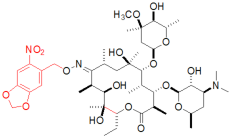
Caged erythromycin for light-activation of gene function in bacterial cells. [76]
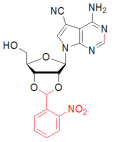
Caged toyocamycin for light-activation of gene function in mammalian cells. [42]

Caged IPTG for light-activation of gene function in bacterial cells. [24]
materials for genetic encoding of unnatural amino acids



Alkyne-modified lysine for protein bioconjugation. [48]

Azide-modified lysine for protein bioconjugation. [48]

Lysine photocrosslinker for protein-protein interaction studies. [68]

Plasmid encoding photocaged Cre recombinase. [46]


Plasmid encoding photocaged T7 RNA polymerase. [58]

Plasmid encoding photocaged zinc-finger nuclease. [74]
materials for small molecule inhibition of microrna function

MicoRNA miR-122 inhibitor. [62]

MicoRNA miR-21 inhibitor. [36]

Plasmid encoding a miR-122 luciferase reporter. [62]

Huh7 cell line stably encoding a miR-122 luciferase reporter. [84]
